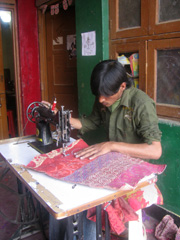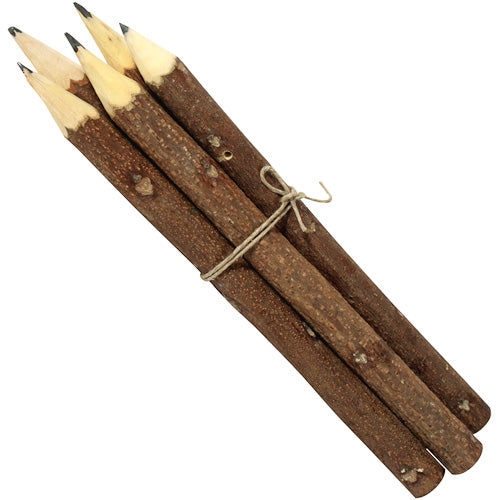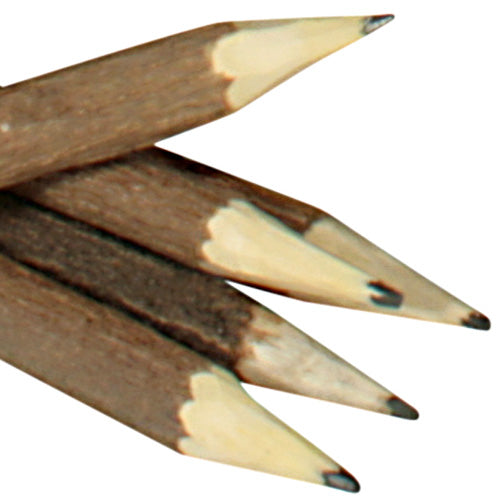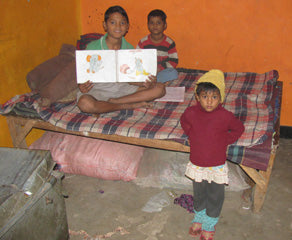OWP
Set de 5 Lápices de Madera de Neem
Set de 5 Lápices de Madera de Neem
No se pudo cargar la disponibilidad de retiro
Los lápices de neem son un concepto único desarrollado por el Sr. Sunil Gupta, un defensor de los niños y jóvenes del hogar de acogida de Lakshya. El Sr. Gupta ha formado a varios jóvenes de Lakshya que trabajan en su centro para crear estos lápices naturales. Para estos lápices se utilizan ramitas de neem desechadas y no se daña ningún árbol en la fabricación de este producto. Disponible en grafito regular y opciones de colores. ¡¡Gran regalo para niños y artistas en ciernes!!
Estos lápices especiales están hechos por jóvenes del refugio Lakshya en Faridabad, India. Lakshya apoya principalmente a niños y jóvenes que han huido de sus hogares. Lakshya envía a los niños más pequeños a las escuelas locales y los jóvenes reciben formación profesional para ganarse la vida y mantenerse. Compre estos productos únicos y apoye el objetivo de Lakshya de brindar mejores instalaciones a estos niños.
- Cada lápiz mide 7” de largo, el diámetro varía
- Disponible en un paquete de cinco lápices.
Hecho a mano en India e importado de Comercio Justo.
Lakshya, es un centro de rehabilitación infantil y juvenil ubicado en un pequeño pueblo de Bhatola, Faridabad, a pocos kilómetros de Delhi. Lakshya fue fundada en 2004 por dos hermanos, Rajeev y Umesh; Comenzaron capacitando a algunas mujeres de la aldea en la fabricación de bolsas de periódicos. Las mujeres de la aldea crecieron de 8 a 150 a lo largo de los años y hoy fabrican bolsas de papel para periódicos y otros tipos de embalaje que se suministran a varias tiendas en la India.
 Rajeev y Umesh formaban parte de un programa de rehabilitación juvenil más amplio, Karm Marg en Nueva Delhi. Comenzaron su propia iniciativa con el nombre de "Lakshya", que significa meta. Con el apoyo de Salam Balak Trust, un conocido centro de rehabilitación de niños y jóvenes, Lakshya actualmente dirige un centro en la aldea. Muchos jóvenes y niños que se han fugado de sus hogares o han quedado huérfanos se encuentran en lugares públicos como estaciones de tren y paradas de autobús. La red de personas de Lakshya, que vigilan de cerca estos lugares y mantienen un contacto regular con la policía local, llevan a estos jóvenes y niños al refugio. En algunos casos, se contacta a los padres o familiares y los niños son devueltos, en otros casos permanecen en el refugio por un tiempo y vuelven a escapar, mientras que otros se quedan. Actualmente, Lakshya apoya a un grupo mixto de 25 jóvenes y niños de entre 7 y 25 años.
Rajeev y Umesh formaban parte de un programa de rehabilitación juvenil más amplio, Karm Marg en Nueva Delhi. Comenzaron su propia iniciativa con el nombre de "Lakshya", que significa meta. Con el apoyo de Salam Balak Trust, un conocido centro de rehabilitación de niños y jóvenes, Lakshya actualmente dirige un centro en la aldea. Muchos jóvenes y niños que se han fugado de sus hogares o han quedado huérfanos se encuentran en lugares públicos como estaciones de tren y paradas de autobús. La red de personas de Lakshya, que vigilan de cerca estos lugares y mantienen un contacto regular con la policía local, llevan a estos jóvenes y niños al refugio. En algunos casos, se contacta a los padres o familiares y los niños son devueltos, en otros casos permanecen en el refugio por un tiempo y vuelven a escapar, mientras que otros se quedan. Actualmente, Lakshya apoya a un grupo mixto de 25 jóvenes y niños de entre 7 y 25 años.
En Lakshya, los niños más pequeños, de entre 7 y 16 años, son enviados a las escuelas locales. Debido a la limitación de fondos, la organización no ha podido patrocinar a niños para que continúen con sus estudios. Así, los jóvenes aprenden varias habilidades vocacionales que les ayudarán a ganarse la vida en el futuro. Se capacita a 5 o 6 jóvenes en la confección de bolsos de patchwork y otros accesorios como fundas para diarios, carteras, carteras y cinturones. Otras formaciones vocacionales incluyen trabajos administrativos, cocina y catering, mecánica automotriz, etc. Lakshya vende bolsos hechos a mano y otros productos elaborados por estos jóvenes en el refugio a través de exhibiciones y algunas tiendas en toda la India. La organización espera rescatar y rehabilitar a más niños y jóvenes que se han escapado de sus hogares y está constantemente tratando de brindarles una forma de vida más significativa.
Share
About the Artisans
About the Artisans
 Joyeria Semilla meaning Seed Jewelry is a small fair-trade workshop in the Andean town of Villa de Leyva, Colombia. Girasol Taborda, a local artisan and social entrepreneur, started the workshop in the mid-1990s.
Joyeria Semilla meaning Seed Jewelry is a small fair-trade workshop in the Andean town of Villa de Leyva, Colombia. Girasol Taborda, a local artisan and social entrepreneur, started the workshop in the mid-1990s.
Joyeria Semilla’s objective is three-folds; to create new jobs, revive Colombia's handicrafts sector and to motivate locals to better manage their natural resources. The organization works primarily with socially and economically disadvantaged youths, single mothers and people with disabilities in the area. The company offers free training in product design, technical training and marketing to new members. Joyeria Semilla has trained them in the craft of jewelry-making.

Caña Flecha or “Gynerium Sagittatum” is a locally found palm tree in the regions of the Caribbean coast. The leaves from this plant are used for making jewelry, woven hats, bags and baskets. The Zenú Indians were and their descendants inherited the tradition of picking veins of the green palm leaf for weaving. These veins were made into woven hats and other products for their personal use.
The Zenú culture is said to have existed between 200BC to1600AD. With the arrival of the colonizers in the 16th century, the indigenous community declined of unknown reasons. Today a very small population remains that claims the inheritance of the almost extinct Zenú tribe. Known for their skills in the construction of major waterworks, canals and irrigation system along with being skilled goldsmiths, examples of their accomplished craftsmanship are found in various museums around the world. Their larger means of subsistence were hunting, farming, fishing and trading.
Caña Flecha is found in abundance in the region, and hence makes for a sustainable and naturally available raw material for these products. Every bit of the plant is utilized – from using in building walls and roofs in houses to food for cattle and medicinal purposes. It is from the central vein of the leaf that the fibers for weaving are obtained. After the hard surface is peeled off, the fibers are left in the sun to dry and undergo a natural tinting process; these fibers are barely about 1 millimeter in thickness and hence call for a lot of skill and patience to weave with. The dried fibers are then processed for natural coloration - some are boiled with lemon to whiten them and some are treated with mud and boiled with plantain leaves to blacken them. The designs are based on ancient motifs and mathematical representations, which are inspired by the early Zenú culture.






